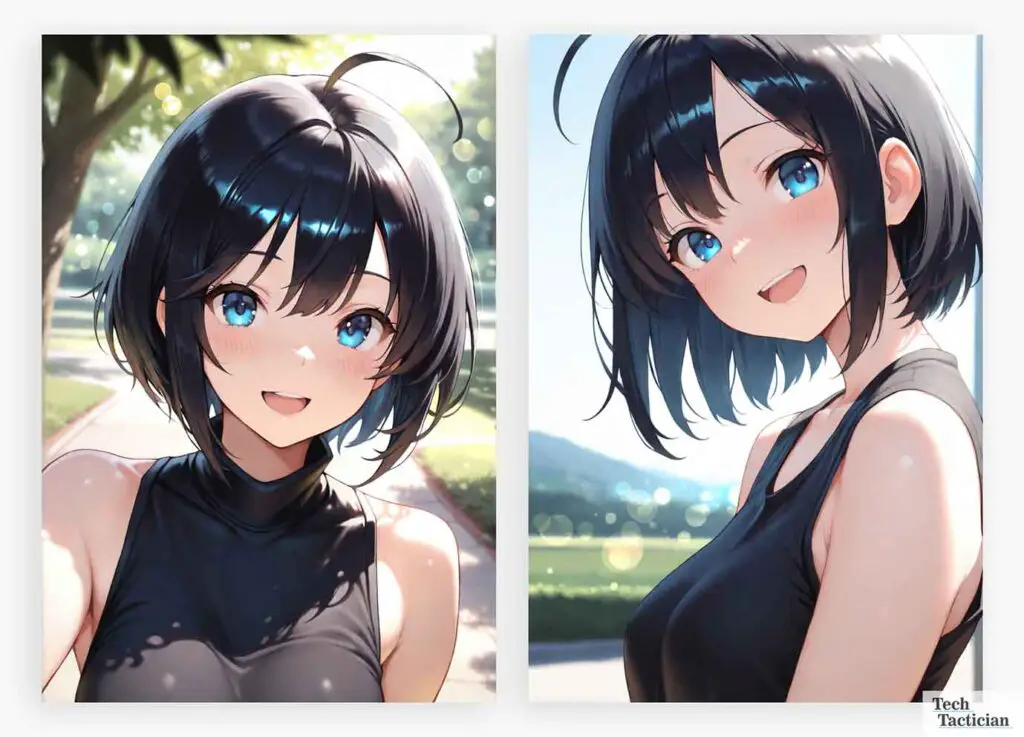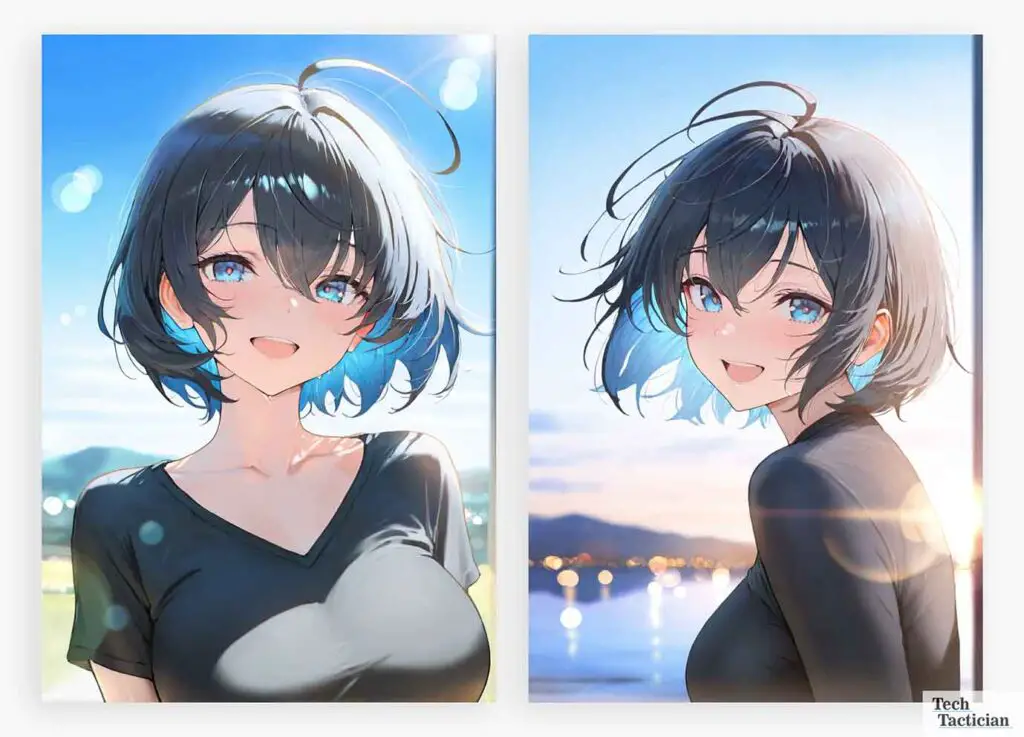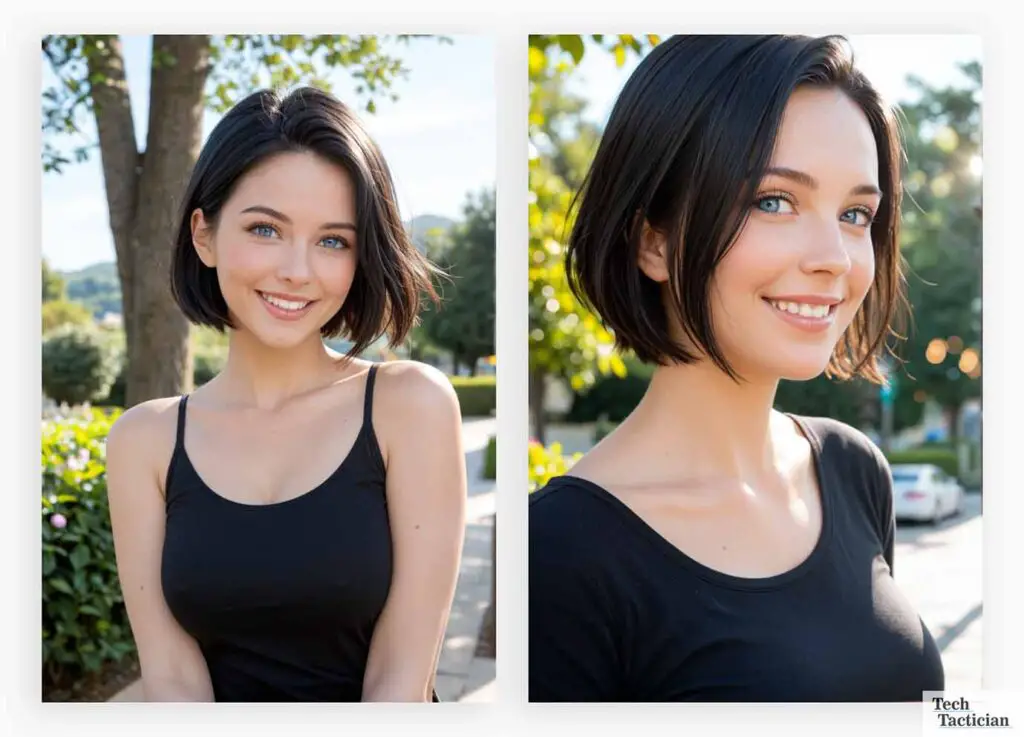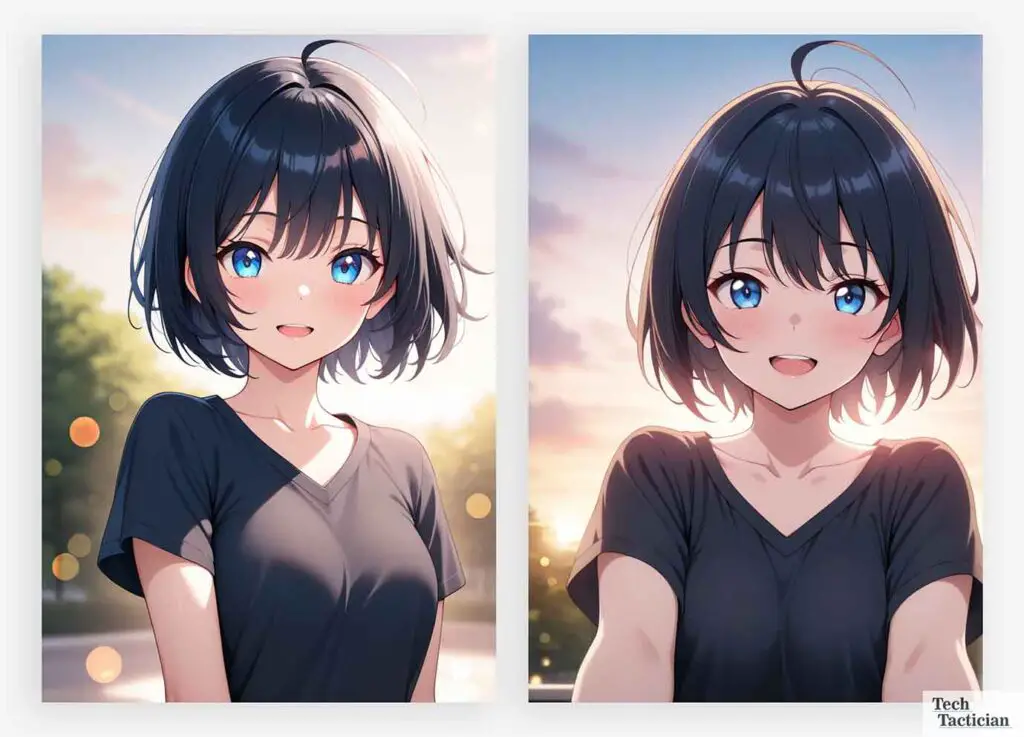Let me show you a few of the best Illustrious XL fine-tunes for generating anime-style images with generated image examples for each of the checkpoints listed. I’ve made this small model comparison roundup based on my personal preference, as well as the popularity of these checkpoints in online communities (CivitAI, Reddit). For all of the models I’ve prepared a set of images generated using the same prompts and generation settings. Enjoy!
Not sure where to start? I’m here to help! – Beginner’s Guide To Local AI Image Generation Software – How To Get Started Quickly
Quick Reference – My Tested Favorites TL;DR
- Diving-Illustrious Anime – my go-to model for quick quality anime-style outputs with minimal short tag-based prompts. Responds pretty well to basic latent upscaling workflows. Hard to get bad outputs from this one. Best used with CFG values 4 and below.
- WAI-Illustrious-SDXL – with both censored and uncensored variants available, this is one of the most popular and most flexible Illustrious XL fine-tunes out there next to Hassaku XL.
- The Plant Milk Model Suite – each of the variants from the suite has its unique flavor and style, can grant you really creative outputs, and works great with basic booru-style prompts. Overall one of the most interesting set of Illustrious fine-tunes to try if you feel like you’ve tested most of the base “traditional” ones already.
Base Illustrious XL vs. Noob & Other Fine-Tunes
Illustrious XL is a Stable Diffusion XL-based model released in 2024 by OnomaAI Research that has slowly become one of the most common foundational SDXL models for generating high-quality anime-style images.
Over time, many new fine-tuned versions of the base Illustrious XL checkpoint came about, being much more efficient at what the original version of the model did, each offering a unique style, aesthetic, and improved prompt understanding (mostly relying on booru tags). These fine-tuned versions of Illustrious XL trained by the community are what we’re going to cover here.
A Quick Note on Booru-Style Tags & LoRA Compatibility
A key aspect of using these models is “booru-style” tagging. This means using descriptive image tags separated by commas (e.g., 1girl, solo, blue hair, long hair) rather than basing your prompts mostly around natural language sentences.
This method, originating from image boards like Danbooru, is the main way of prompting most Illustrious-based checkpoints and model merges. While you can also use some natural language in your prompts, most of these models will always respond to these tags much better.
LoRA compatibility is also important here. Most Illustrious-based models work best with LoRAs designed for the SDXL architecture, not those made for other models like Pony. Keep that in mind when searching for compatible LoRAs for the models listed below.
The Test Images and The Main Testing Prompt

To provide a consistent comparison, the sample images for each model below were generated using a similar positive and negative prompt structure. This short methodology involved using the same prompts with minor adjustments to the CFG (Classifier-Free Guidance) scale as needed (between 2 and 7). This is because each of the checkpoints responds to the CFG value setting differently.
Different CFG scale value settings used have been listed in the captions of the generated images in the examples below. Each of the images was generated with the Euler Ancestral sampler and Karras scheduler with 30 generation steps.
Here are the exact base prompts used for the test:
Positive prompt:
masterpiece, best quality, amazing quality, solo, 1girl, adult, upper body, black hair, short hair, ahoge, blue eyes, smile, looking at viewer, open mouth, black top, outdoors, highres, (depth of field), bokeh, diffused light, sunshine, extremely detailed background, extremely detailed foregroundNegative prompt:
(worst quality, low quality, bad quality), bad anatomy, lowres, bad hands, jpeg artifacts, bad proportions, ugly, poorly drawn, deformed eyes, deformed hands, deformation, blurry, dark, multiple views, text, cropped
Next to each model listing I will also share some of my observations made when playing around with the checkpoints in ComfyUI.
A Quick Note on Latent Upscaling
While all of the models listed below can be used with the more advanced customized latent upscaling workflows, having additionally tested them with the latent upscaling method showcased in this tutorial (without the use of any custom nodes), I found that only a few of these responded to the standard single-run 2x latent upscale with 0.50 denoise setting without significant image artifacting.
The models I found to perform very well with basic high-denoise value latent upscaling were: Diving-Illustrious Anime, Hassaku XL, and both CyberRealistic CyberIllustrious and Realism Illustrious.
10 of The Best Illustrious XL Fine-Tunes & Merges (With Image Examples)
This list, as I’ve already mentioned, was built both according to my own tastes, and the frequency I found each of these checkpoints mentioned and used in many places online including CivitAI and Reddit gen-AI communities.
Pure Anime-Style Illustrious XL Fine-Tunes
1. Diving-Illustrious Anime
Diving-Illustrious Anime is in my honest opinion one of the best and easiest to prompt flavors of the base Illustrious XL model. Because of that, we’ve used it both in this basic ComfyUI workflows tutorial, as well as in the detailed Illustrious XL image generation an prompting guide that you can find here: Illustrious XL ComfyUI SDXL Anime Beginners Guide.
This model is known for generating well-structured faces and bodies out of the box with minimal corrections, and responds very well to short and simple booru tag-based prompts. This is definitely my favorite checkpoint on this list, and it’s really great if you’re just starting out. It responds very well to basic latent upscaling workflows, and is best used with rather low CFG scale values (below ~4).
2. WAI-Illustrious-SDXL
WAI Illustrious SDXL is among the most popular Illustrious XL fine-tunes out there next to Hassaku XL, having both censored and uncensored versions available. This model is quite frequently updated with new character data and is known for its vast knowledge of characters from various popular anime and games.
With basic prompts such as ours, it defaults to the generic quality anime illustrations style which is easy to further guide towards your desired outcomes. Its compatibility with Illustrious LoRAs is also very much on-point. Overall, it’s one of the best “safe-bet” options if you want a solid, reasonably style-neutral place to start.
3. NoobAI-XL (NAI-XL)
NoobAI XL, although not the freshest Illustrious XL fine-tune, is still one of the more commonly chosen “classic” choices. It comes in two main versions: epsilon-prediction and v-prediction. The v-prediction version showcased above, is known for its rather distinct style in comparison to other Illustrious XL-based checkpoints. It can yield really interesting results, provided you’re ready to tweak your usual prompts to be compatible with its sometimes hard-to-tame prompt response.
In any case, the base NoobAI checkpoint still is a pretty popular option over on sites like CivitAI in both of its variants, and is a great model to check out if you decide you want to try out something new. For me though, it’s one of the less appealing options given our remaining, much more recent alternatives.
4. Hassaku XL (Illustrious)
The Illustrious version of Hassaku XL is a checkpoint that aims for default bright, style-agnostic anime outputs with basic booru-style prompts. It’s known for producing consistent results, and could be best compared to WAI-Illustrious-SDXL both in terms of its general behavior, as well as prompt handling.
Overall, this is the second option I’d go for if I needed a good neutral starting point for my generations, as well as for Illustrious-compatible LoRA use. Solid model, with a great backing from the community. It also features a separate version based on PonyXL.
You might also like: ComfyUI FaceDetailer – Quick Starter Guide
5. The Plant Milk Model Suite (Vanilla, Walnut, etc.)
The “Plant Milk” model suite is a set of related model merges based on Illustrious and NoobAI models. Quite honestly, it’s another one of my favorite picks on this list, aside from the Diving-Illustrious Anime checkpoint that I’ve mentioned first. The collection includes several different style “flavors” like Almond, Walnut, Vanilla, or Oat, each with a slightly different default output aesthetic.
Despite being trained towards differing output aesthetics, these models are very versatile and can produce a wide range of generations. Walnut is one of the more recent and popular versions. On the image above, you can see the images generated using the “Hemp” variant of the model, which we got in the first two subsequent tries with the use of our default testing prompt. This vibrant and high-contrast output style is really pleasant to build up from, at least in my opinion.
6. NTR MIX (Illustrious-XL | Noob-XL)
The NTR Mix is one of the most interesting “creative” Illustrious XL fine-tunes able to introduce a very distinct and artistic flair to your creations, while still being able to default to the stock “clean” anime style you can see represented with our basic test prompt used to create the images shown above. It is a neat fusion of Noob-AI and base Illustrious-XL models, and it’s known for its ability to create unique color tones and painterly backgrounds with some more advanced prompting techniques.
Despite it not being as fresh as the other options on this list, it’s still among the most commonly downloaded models over on CivitAi (over 100k downloads at the time of writing this article). It’s also very LoRA-friendly, making it a another interesting choice when you’re looking for a good place to start. Another great option to try out!
Realistic & 2.5D/3D Illustrious Merges
7. CyberRealistic CyberIllustrious
With the CyberRealistic CyberIllustrious checkpoint, we enter the world of the realistic and semi-realistic Illustrious XL-based fine-tunes. Although this one is obviously geared towards generating photos and 3D imagery closely resembling real life, it can also grant you very impressive results when it comes to 2.5D anime-style generations.
This one, when prompted with anime tags like our base test prompt will grant you results that you can see above. However, when pushed towards more synthetic look using appropriate tags, it can also produce quite unique 2.5D or 3D rendering style outputs. It’s very fun to experiment with!
8. Realism Illustrious by Stable Yogi
Realism Illustrious is another model meant mainly for generating realistic images, this time created by Stable Yogi. Much like CyberIllustrious, it can be steered toward a 2.5D anime style, but its default outputs responding to booru-style prompts look exactly as you can see above.
While it might seem pretty similar to CI at the first glance, I much prefer it when it comes to body proportions and detailed backgrounds without much prompt-jutsu at play. It’s definitely worth trying out if you’re leaning towards more realistic creations, but still want to utilize booru tags to prompt the model.
Bonus: Anime Screenshot Merge NoobAI
The Anime Screenshot NoobAI Merge is a checkpoint made with emulating the look of screengrabs taken straight from a TV anime series. Its style is intentionally less detailed and painterly, focusing on the flat colors and cel-shaded look typical of TV anime series. It’s a v-prediction model much like NoobAI, so it works best with a low CFG scale (around 3-5) and the Euler Ancestral sampler.
With our testing prompts, it gave us a neat and soft generic output, but with some work done on the default positive prompt it was reasonably easy to tilt the outputs towards what a scene from an actual anime episode could look like. Yet another one that I found really interesting.
Which One To Choose As a Beginner? – And The One I Use The Most
The quick answer is, for beginners, I wholeheartedly recommend Diving-Illustrious Anime that is mentioned first on our list. It’s incredibly straightforward to use, and doesn’t require complex negative prompts or a deep understanding of booru tagging to get good results. The outputs are clean, aesthetically pleasing, and it serves as an excellent starting point for learning how to prompt for anime styles. It works great out-of-the-box with interfaces like ComfyUI, which is why I’ve featured it in a few of our AI image generation tutorials.
If you’re aiming for the more style-agnostic picks (models that do not impose their own style), two great picks are the WAI-Illustrious-SDXL, or Hassaku XL. These are commonly chosen by both beginners and more advanced users, and there are many great tutorials for them available online.
If you’ve already used a few models like this, and you want to try something new, the whole Plant Milk Model Suite is a great and fresh checkpoint based around a few unique styles you can treat as starting points for your new creations. I personally, have found these ones really interesting.
With that said, I hope this model comparison was helpful to you, and you were able to find something for yourself. If not, you can search for some more inspiration both when it comes to SDXL models you can use, and quality images created using them along with their prompts. You can use many different websites for that, and here you can find a few of best best ones out there: 6 Sites Like Civitai – Best Alternatives Available. Until next time!











